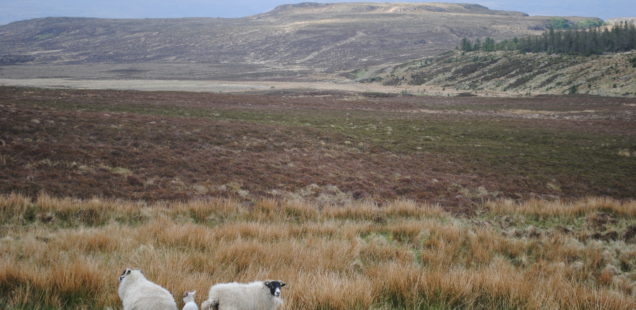
Lovely people, tasty food & some history –
a trip through the High- and Lowlands
More than 1200 miles in 12 days, millions of sheep and most amazing nature – that is how you could sum up our Scotland trip. But there is much more to these days we travelled through this beautiful and lovely country: the friendly people, the great hikes, the diverse landscape, the historic sights, …
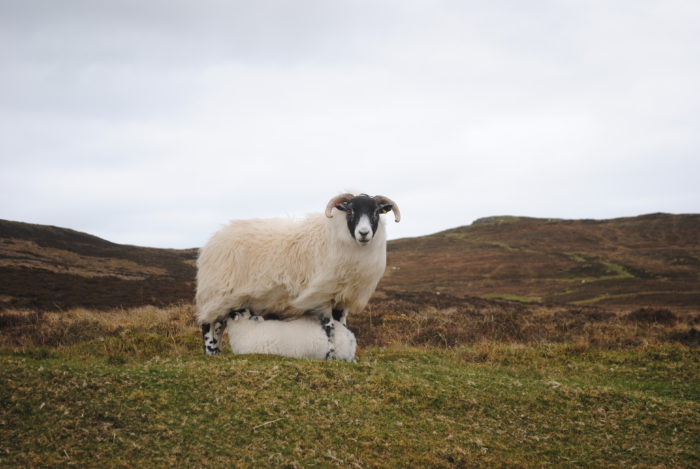
It happened that we chose May for our trip, the so-called „golden month“ – turned out to be an excellent decision. The weather was good (most of the time) and all cities and regions just seemed to awaken from their winter sleep.
Culinarily Britain is not known for a very excellent cuisine and I have to admit that I never ate that many fries before in my life! But there are some things really worth trying: Fresh sea food, very well made burgers and some sweet treats.
DAY 1 – Explore an underestimated city
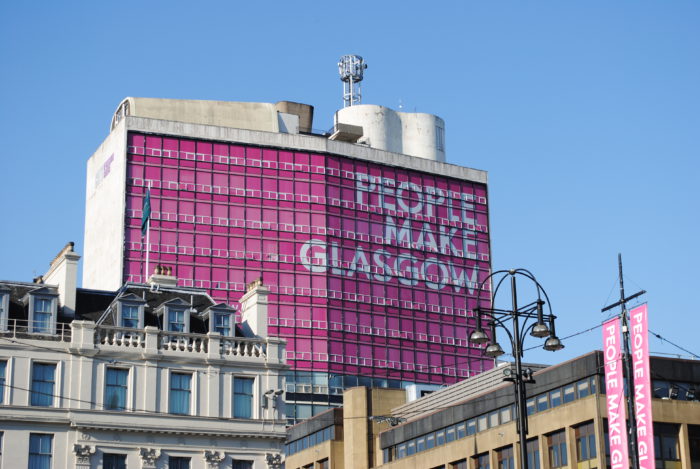
‚People make Glasgow‘ © Lisa Lehnen
We landed in Edinburgh mid-day, picked up our car and drove two hours to Glasgow. Contrary to all prejudices this city really surprised us. It is vibrant and colourful in some parts, you can find lots of street art works, small cafés and restaurants, bars and clubs around Glasgow city centre. If you only have a few hours, walking around is probably the best way to get an overview and get to know the city.
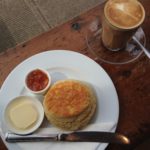 Enjoy a homemade scone with jam and clotted cream with a coffee at the Cottonrake Bakery (497 Great Western Road, Glasgow City G12 8HL). Or try something from the really good looking cake counter.
Enjoy a homemade scone with jam and clotted cream with a coffee at the Cottonrake Bakery (497 Great Western Road, Glasgow City G12 8HL). Or try something from the really good looking cake counter.
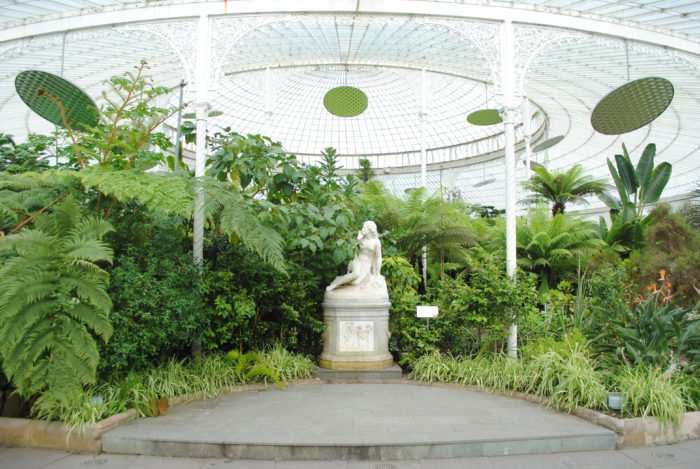
Home of the plants: Kibble Palace © Lisa Lehnen
The Glasgow Botanic Gardens date back to 1817 but moved to their present place in Kelvinside in the late 1830s. The biggest, most impressive glass house in the southeast of the park is known as Kibble Palace, named after John Kibble, an engineer, astronomer and photographer. Built in the 19th century it underwent restoration from 2004 to 2006. The structure is made of cast iron, steel and glass and it is home to a variety of plants and numerous sculptures. Have a look at the flower beds and go for a walk.
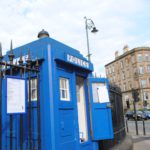 Don´t miss the little blue coffee place by the south entrance (Great Western Rd / Queen Margaret Dr), a former police booth. Just across the street, you will find Òran Mór, an event location that used to be the Kelvinside Parish Church. In Gaelic, the name means ‘great melody of life’ or ‘big song’ – suitable for the arts and entertainment venue in the heart of Glasgow’s West End. It hosts two bars, two restaurants, a Live Music venue, a Night Club and an Auditorium.
Don´t miss the little blue coffee place by the south entrance (Great Western Rd / Queen Margaret Dr), a former police booth. Just across the street, you will find Òran Mór, an event location that used to be the Kelvinside Parish Church. In Gaelic, the name means ‘great melody of life’ or ‘big song’ – suitable for the arts and entertainment venue in the heart of Glasgow’s West End. It hosts two bars, two restaurants, a Live Music venue, a Night Club and an Auditorium.
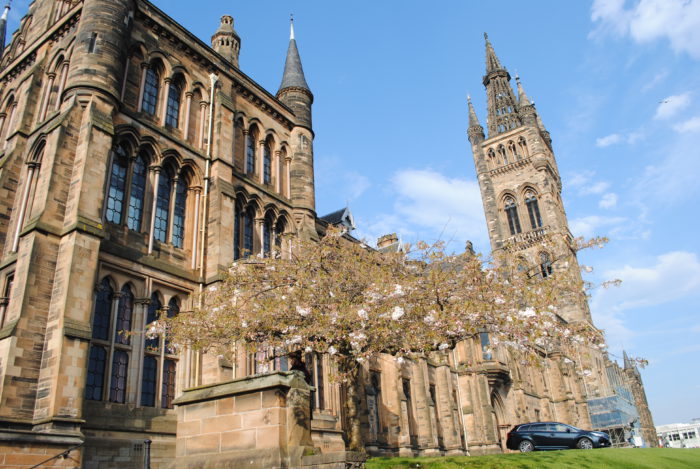
University of Glasgow © Lisa Lehnen
The long-established University of Glasgow finds itself in a very impressive old building on top of Gilmorehill and high above Glasgow´s Westend. Not only the building itself but also the view is worth a visit. Among other things, you can spot the Kelvingrove Art Gallery and Museum as well as the ultra-modern Scottish Exhibition and Conference Centre and the Science Centre beside the River Clyde. Students of the University and others use the nearby Kelvingrove Park, located between the city centre and the Westend and crossed by River Kelvin, as leisure and walking space.
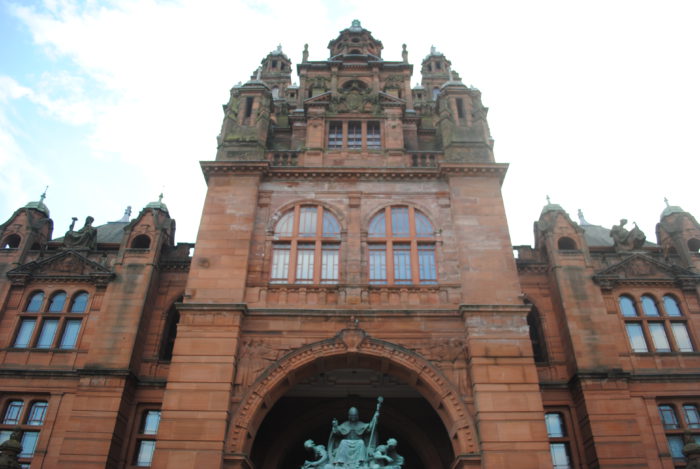
Kelvingrove Art Gallery and Museum © Lisa Lehnen
A real gem of Glasgow´s Art Deco Heritage can be found on Sauchiehall Street: Designed in 1937 to provide accommodation for visitors to The Empire Exhibition of 1938 The Beresford Hotel today still is a great example of the Art Deco/Streamline Moderne style. It is said to be the first skyscraper in the city. Known as Baird Hall it was temporally used as accommodation for students of Strathclyde University and has now been refurbished as 112 apartments. Usually, there is no public access to the building, but we got to sneak in and got a glimpse at some of the internal deco elements as well.
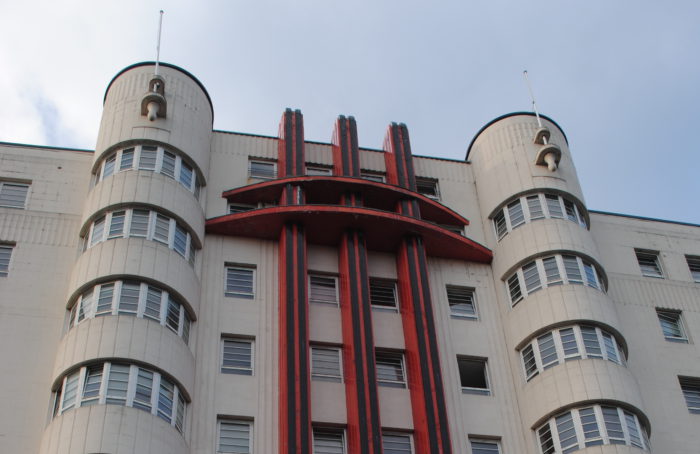
The Beresford House © Lisa Lehnen
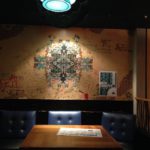 The Music Bar Nice´n´sleazy on Sauchiehall Street (421 Sauchiehall Street, Glasgow, G2 3LG) was known for its burgers for a long time and recommended to us by many people. We were a bit disappointed to find out about the new collaboration with the Babu Bombay Street Kitchen, offering a variety of Indian food. Maybe it is worth a try, but we just had a local beer. Ask the bartender for tastings if you don´t know which one to drink; they are offered in small glasses. The atmospheric bar with rock music sound from the basement is definitely worth a visit, offering club nights, film screenings and bands performing almost every night.
The Music Bar Nice´n´sleazy on Sauchiehall Street (421 Sauchiehall Street, Glasgow, G2 3LG) was known for its burgers for a long time and recommended to us by many people. We were a bit disappointed to find out about the new collaboration with the Babu Bombay Street Kitchen, offering a variety of Indian food. Maybe it is worth a try, but we just had a local beer. Ask the bartender for tastings if you don´t know which one to drink; they are offered in small glasses. The atmospheric bar with rock music sound from the basement is definitely worth a visit, offering club nights, film screenings and bands performing almost every night.
DAY 2 – Visit a Loch & see some more of Glasgow
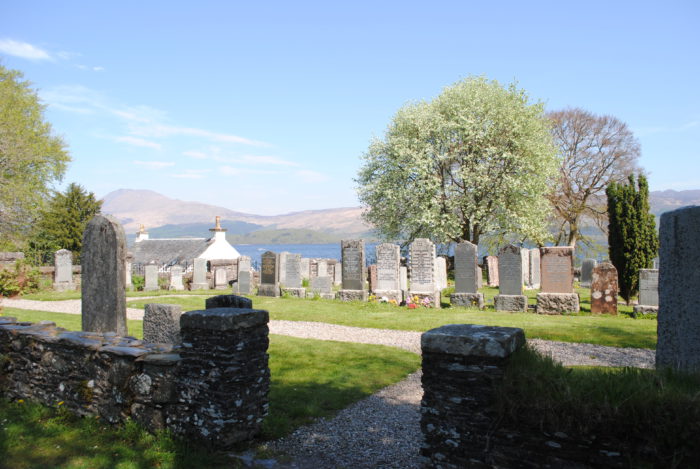
Cemetery of the town of Luss © Lisa Lehnen
Our first stop today was the tourist information in Balloch at the south end of the Loch Lomond, Scotland´s second largest lake, which is part of the Loch Lomond and The Trossachs National Park since it was established in 2002. Due to the fact that we only wanted to spend the morning hours we decided to not drive up to far from there. We parked our car in Luss and went walking around the town and up the local mountain, the Ben Dubh. Somehow we ascended this windy but soft and grassy hill from the wrong side which means not on a regular path. There is an easy access from the street though. From above the Ben Dubh you have an incredible view over part of the Loch Lomond and its small islands. For us as „city kids“ it is just amazing how far you let your eyes wander!

Follow the river path © Lisa Lehnen

Looking over the Loch Lomond © Lisa Lehnen
You can also hop on one of the water buses from several towns around the Loch Lomond that take you to the various islands and towns around the lake (make sure to check the timetable before as some only leave once or twice a day) and combine that with short or long hikes. Before heading back to Glasgow a small gift shop and a coffee & ice cream place in Luss offer hearty and sweet snacks.
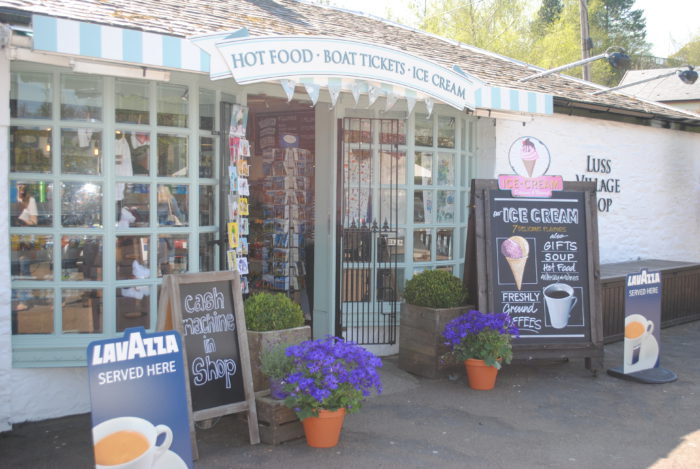
Snack and shop at the Luss Village Shop © Lisa Lehnen
Back in Glasgow, we took another stroll through the city. In the 1890s Glasgow was a financially rich city with many social and environmental problems due to the rapid industrialization it experienced in the second half of the 19th century. During this time a new style of art and architecture was adopted in the context of an industrial metropolis: the Art Nouveau, also known as Glasgow Style. Evolving from the Glasgow School of Art, which was influenced by the Arts and Crafts Movement, the city had its own cultural or architectural traditions for the first time. Charles Rennie Mackintosh became especially famous. His work includes the Glasgow School of Art itself, a building that still remains an important part of the history of European architecture today.

Lively Georg Square © Lisa Lehnen
George Square is the central plaza with the city hall. Glaswegians, how the inhabitants of the city are called, often use it during lunch time or festive events. I just love that kind of places with their urban vitality – you can immerse right into the culture.

Passing by the Gallery of Modern Art you can see the equestrian statue of the Duke of Wellington with the red-white pylon on his head – modern art, I guess… But also a great demonstration of Scottish humour.
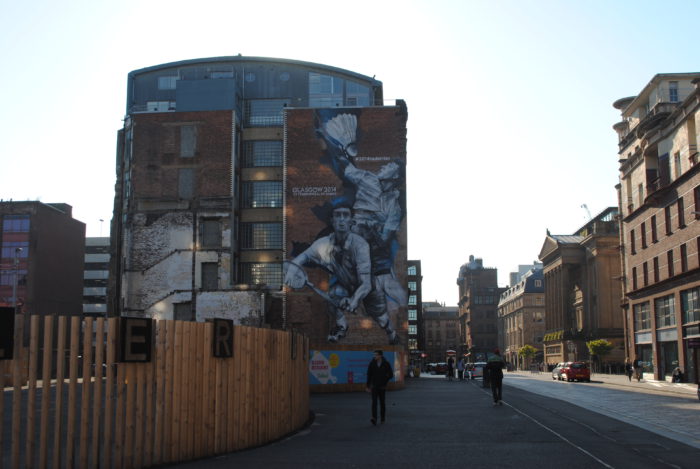
Where old meets new meets art: the Merchant City © Lisa Lehnen
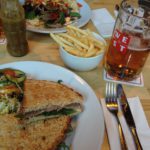 Take a walk through southeastern Merchant City, the former trade quarter of Glasgow, where the prosperity of the tobacco industry faces the deterioration of the post-industrial city. Eat some great food and drink some good local beer at Bar 91 (91 Candleriggs, Glasgow, Lanarkshire G1 1NP). Don´t miss out on the dessert!
Take a walk through southeastern Merchant City, the former trade quarter of Glasgow, where the prosperity of the tobacco industry faces the deterioration of the post-industrial city. Eat some great food and drink some good local beer at Bar 91 (91 Candleriggs, Glasgow, Lanarkshire G1 1NP). Don´t miss out on the dessert!

A typical Scottish pub: Bar 91 © Lisa Lehnen
Unfortunately, we did not get a chance to visit the Riverside Museum, since 2011 home to the Glasgow Museum of Transport. Designed by famous architecture firm Zaha Hadid Architects the museum even won the European Museum of the Year Award in 2013. Saved that one for the next time!
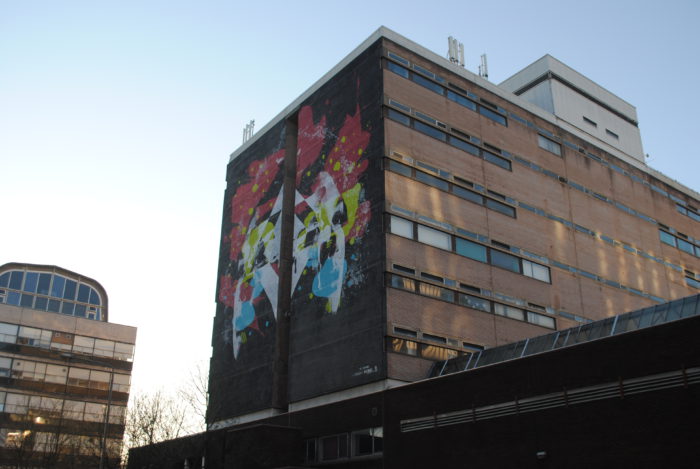
One of the many murals that can be seen in Glasgow – really worth exploring © Lisa Lehnen
DAY 3 – Take the train to the sea
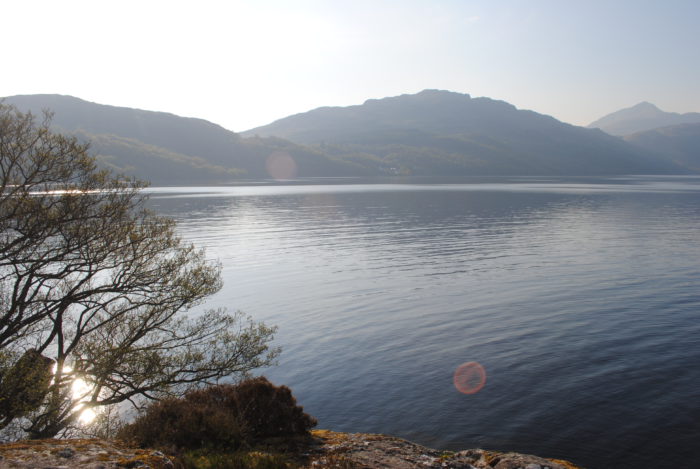
Lots of beautiful views on the way © Lisa Lehnen
Early in the morning, we drove up to Fort William to catch the Jacobite Train (it´s the beautiful red steam train from the Harry Potter movies) at 10.15 am. You have to get some scones at the station, they are really good. Buy some and take them on the 2-hour-train ride.
Since 30 years now the steam train runs the 84-mile round trip, often described as one of the greatest railway journeys in the world. Be prepared to breathe in some black steam while passing through tunnels – it is really an experience! The train passes the 21-arched Glenfinnan viaduct which overlooks Loch Shiel and the Jacobite monument approximately half way. The view from the 1.000 ft (300 m) span bridge is magnificent!
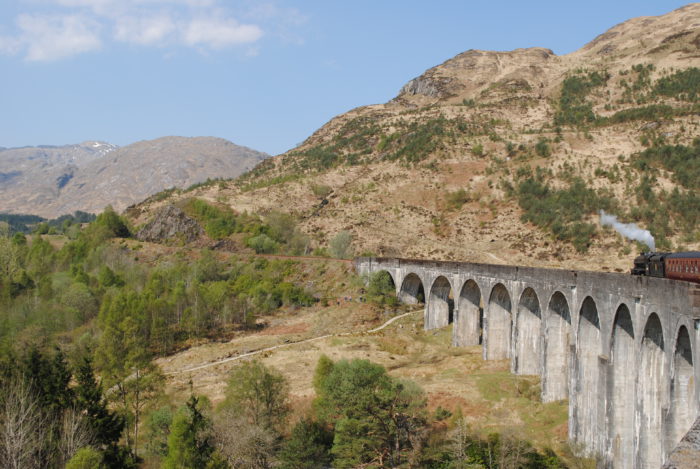
Amazing view on and from the Glenfinnan Viaduct © Lisa Lehnen
After a quick stop at the village of Glenfinnan the train travels through Lochailort, Arising (stop only on request) and Morar. On the way, you will see Loch Morar and the silvery beaches (to be seen in the films “Highlander” and “Local Hero”) as well as the deepest seawater loch in Europe, Loch Nevis.
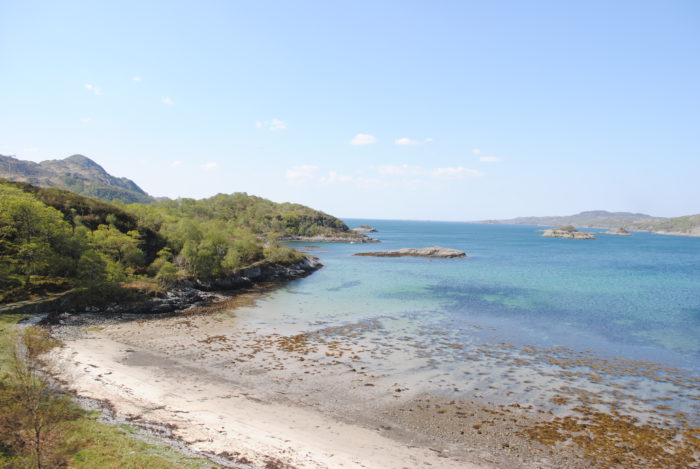
Is this still Scotland? © Lisa Lehnen
The final stop of the trip is the small fishing village Mallaig (806 inhabitants) at the Scottish west coast. It was founded during the 1840s by Lord Lovat, the owner of the North Morar Estate, as a harbour. Today it is an important fishing port and ferry terminal with services to Skye and the small isles of the Inner Hebrides: Rùm, Canna, Eigg, Muck, South Uist and Knoydart.
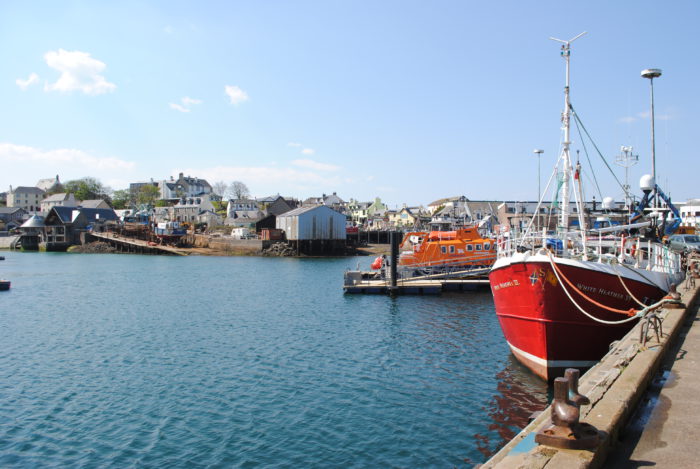
The port of Mallaig © Lisa Lehnen
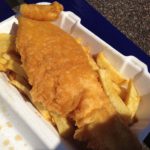 Arriving in Mallaig we had roughly an hour and a half to enjoy a walk around town, some back roads and take in the atmosphere and a salty breeze. There are small shops, bars, restaurants and plenty of fish and chips places. We really enjoyed the simple, typical lunch at the takeaway by the train station. Vinegar and tartare sauce are recommended supplements with the dish. If you like, have some mushy peas as a side order.
Arriving in Mallaig we had roughly an hour and a half to enjoy a walk around town, some back roads and take in the atmosphere and a salty breeze. There are small shops, bars, restaurants and plenty of fish and chips places. We really enjoyed the simple, typical lunch at the takeaway by the train station. Vinegar and tartare sauce are recommended supplements with the dish. If you like, have some mushy peas as a side order.
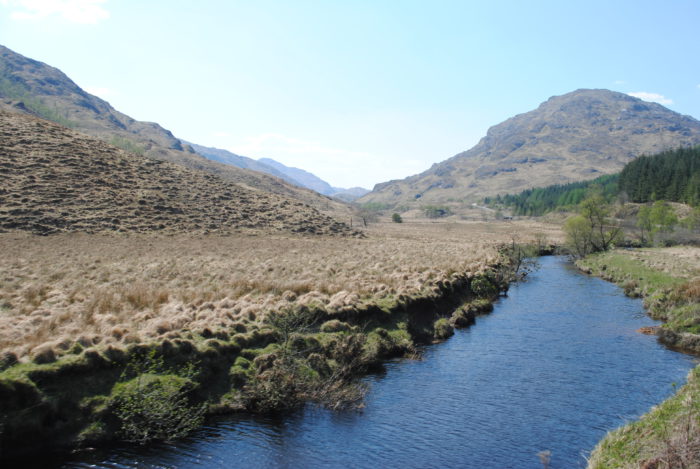
Shortest river in Britain, River Morar © Lisa Lehnen
Tip: Take one of the regular trains (ScotRail) to Mallaig, running several times per day for only £14.20 if you don´t want to spend all the money on the steam train. Same way, same views, same destination.
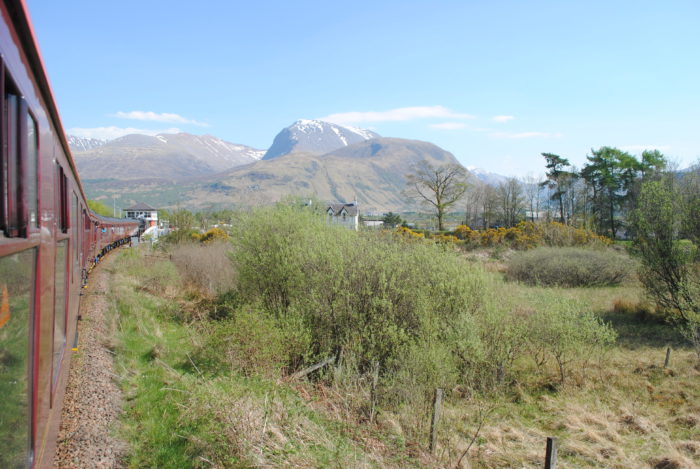
Back to the city by the foot of the mountain: Fort William © Lisa Lehnen
We were back at Fort William with the Jacobite steam train in the afternoon. This leaves some time to explore the city centre or the surrounding of your accommodation. It took us a little while to find our „house“ in Banavie, a small settlement near Fort William. Ben Nevis is only about 2.5 miles (4 km) away. We could even see it from the window of our room – impressive to wake up to!
Fort William is the largest town in the Highlands and situated at the southern end of the Great Glen (Gaelic: An Gleann Mòr), also known as Glen Albyn or Glen More. The long and straight canyon runs for 62 miles (100 km) from Inverness, the capital of the district Highland, to Fort William which lies in the shadow of Ben Nevis, Britains highest mountain.
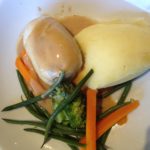 After a walk from our night-quarters, we enjoyed some really good food at the Moorings Hotel (Banavie, Fort William, Inverness-Shire PH33 7LY). From the terrace, you have a good view of Ben Nevis. The food is not exactly cheap, but really tasty. Service is good and water is offered for free with the food.
After a walk from our night-quarters, we enjoyed some really good food at the Moorings Hotel (Banavie, Fort William, Inverness-Shire PH33 7LY). From the terrace, you have a good view of Ben Nevis. The food is not exactly cheap, but really tasty. Service is good and water is offered for free with the food.

Idyllic view on Ben Nevis © Lisa Lehnen
DAY 4 – Climb the highest Scottish mountain
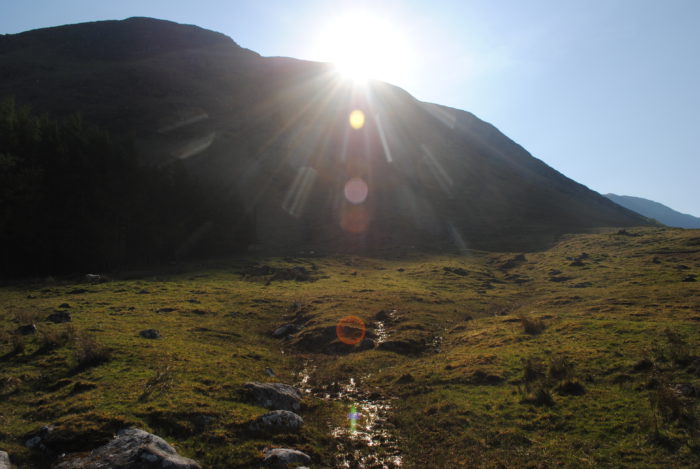
By the foot of the mountain… © Lisa Lehnen
We did it! Today’s challenge was to hike to the top of Ben Nevis, part of the Grampian Mountains and the highest mountain of the British Islands which is why it is often called „the roof of Britain“. The Tourist Route, also known as the Pony Track, has a distance of approximately 16 km (9.94 miles). It took us 7 hours (including an hour rest) to go up and down from 20 m to the peak at an altitude of 1344 m.

Taking a break and a good look around © Lisa Lehnen
The ascent starts off as a steep path with rough stone steps. After reaching a plateau with a lake the terrain becomes very stony. You have to follow a zick zack route further up the hill where it also gets more and snowier. The straining ascent is rewarded by a breathtaking view on craggy rock faces and deep canyons, offshore islands and the fjords. Amazing thought that the magmatic stone of Ben Nevis is already 400 Million years old!
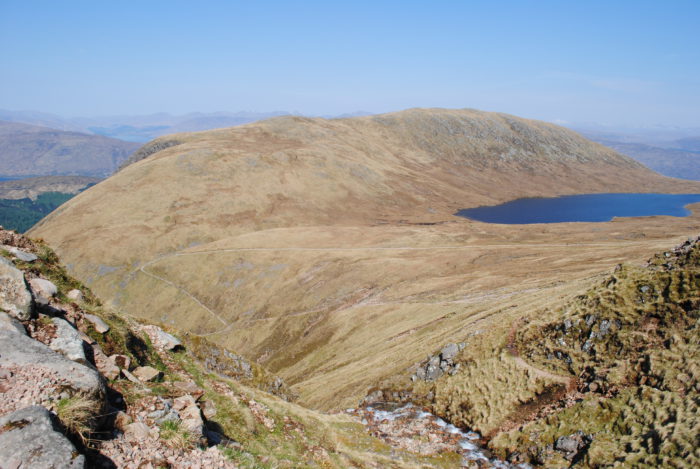
Lake on a mountain plateau © Lisa Lehnen
A meteorological observatory was erected here in 1883 and in use for 21 years to explore and measure the sometimes extremely rough weather conditions of the mountain. The ruins are still visible and perfect to hide from the stiff breeze at the top and eat a little snack.
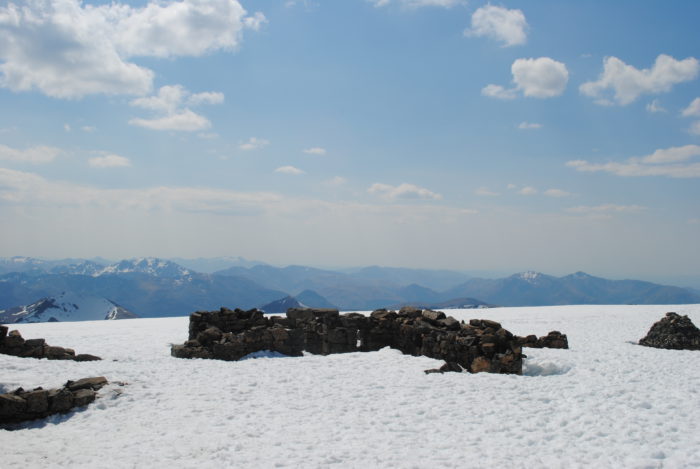
On the top of the mountain: remains from the „hotel“ © Lisa Lehnen
 After the descent, we have really earned a decent cold beer at the Ben Nevis Inn (Claggan, Achintee, Fort William PH33 6TE)! Along we had the very traditional Scottish dish Haggis, Neeps and Tatties and a great Burger with chips and salad.
After the descent, we have really earned a decent cold beer at the Ben Nevis Inn (Claggan, Achintee, Fort William PH33 6TE)! Along we had the very traditional Scottish dish Haggis, Neeps and Tatties and a great Burger with chips and salad.

Lots of sheets by the foot of Ben Nevis © Lisa Lehnen
DAY 5 – See a castle, enjoy Mediterranean flair & explore the famous peninsula
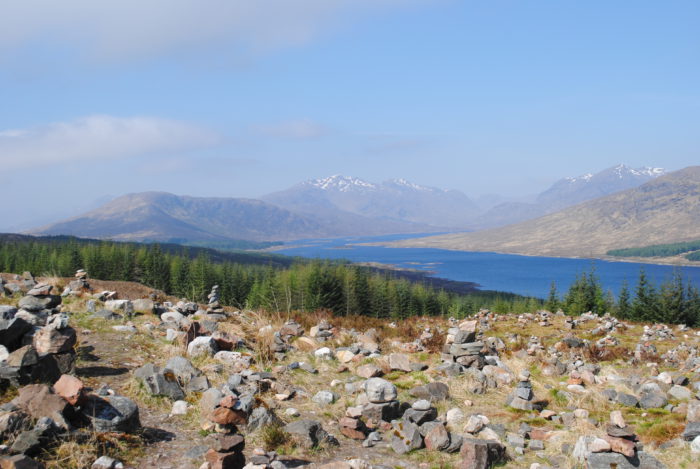
Beautiful views along the way © Lisa Lehnen
Our drive up to north was full of diverse landscapes, views of lakes and mountains.
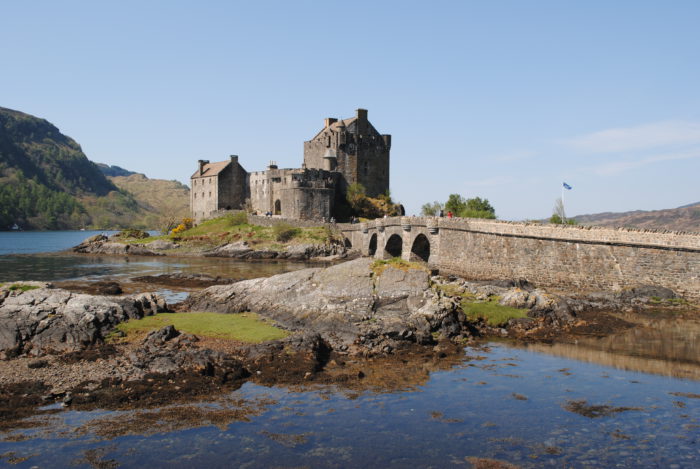
Time to „visit“ the first castle on our way to the Isle of Skye: Eilean Donan Castle (Dornie, Kyle of Lochalsh IV40 8DX). Since 1220 it is the seat of the Macrae Clan and – after restoration – a museum today. The castle was part of several movies, among them also „Highlander“ (1986) and the James Bond movie „The world is not enough“ (1999). We did not go inside (it´s just too expensive) but took some nice pictures from the outside.
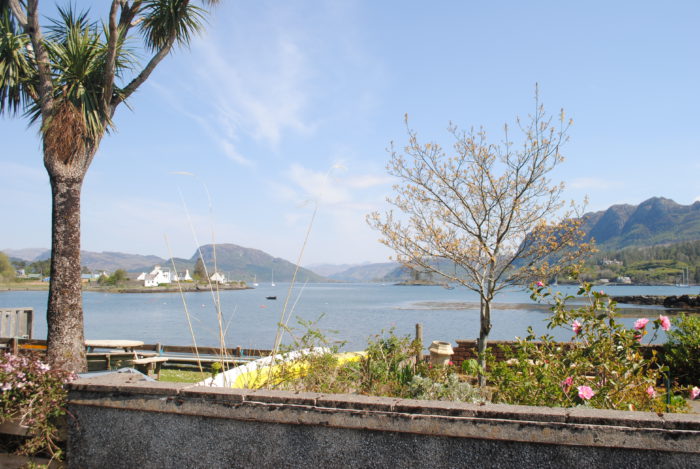
Mediterranean flair in Plockton © Lisa Lehnen
 We did a little trip to the scenic town of Plockton, located in a small bay and in favour of the mild climate of the Gulf Stream. You can find palms here. Enjoy some ice cream and stroll around for a little while – feels like a small holiday while being on vacation.
We did a little trip to the scenic town of Plockton, located in a small bay and in favour of the mild climate of the Gulf Stream. You can find palms here. Enjoy some ice cream and stroll around for a little while – feels like a small holiday while being on vacation.
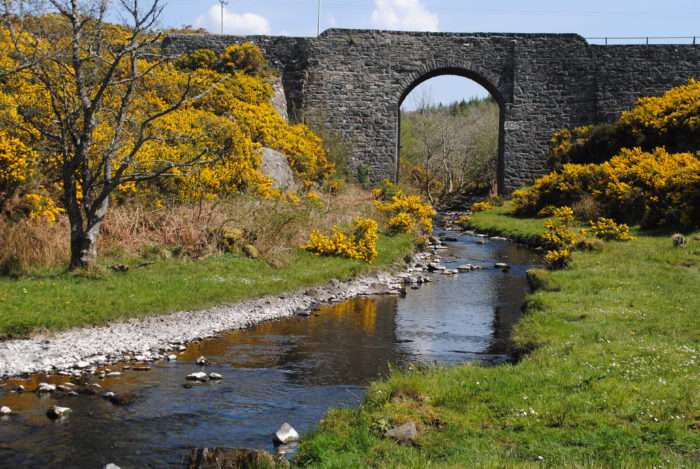
The further drive to the Isle of Skye takes you over the 500 m long Skye Bridge, connecting the mainland with the biggest Inner Hebridean Island since 1995.
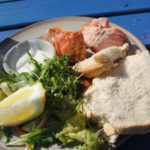 Talisker Distillery was fully booked for the day, so we had some smoked salmon and a local beer on the terrace of The Old Inn (Carbost, Isle of Skye IV47 8SR) instead. The Oyster Shed a mile up the hill also offers a variety of fresh seafood. We tried some Oysters with salt and lemon.
Talisker Distillery was fully booked for the day, so we had some smoked salmon and a local beer on the terrace of The Old Inn (Carbost, Isle of Skye IV47 8SR) instead. The Oyster Shed a mile up the hill also offers a variety of fresh seafood. We tried some Oysters with salt and lemon.
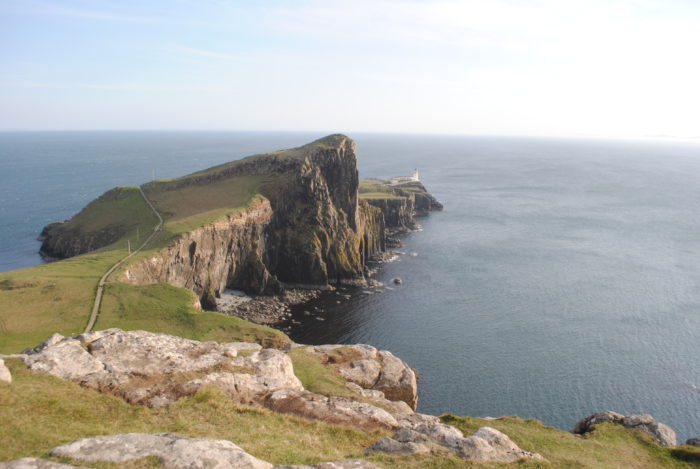
We used the late afternoon to drive all the way to Neist Point, one of the most famous lighthouses in Scotland near Glendale on the most westerly tip of Skye. A looooong single track road takes you straight to the car parking – so don´t turn around, it is coming up for sure. The views on and from the high cliffs are stunning! Take care you do not get blown away by the stiff breeze.
There is an approximately 1-hour-walk down to the lighthouse. Caution: it is a steep path! So it might take you longer for the way up. It was already late and started to get dark, so we did not make it all the way to the lighthouse. Still absolutely worth the drive!
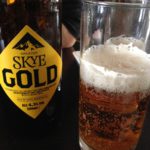 After a veeeery long search for a place to eat we had a late dinner at the Waterside Cafe Bistro & Gallery (Main Road, Atholl Filling Station, Dunvegan, Isle Of Skye, IV55 8WA). Delicious home cooking and a warm welcome await you – along with a very tasty Skye Gold beer.
After a veeeery long search for a place to eat we had a late dinner at the Waterside Cafe Bistro & Gallery (Main Road, Atholl Filling Station, Dunvegan, Isle Of Skye, IV55 8WA). Delicious home cooking and a warm welcome await you – along with a very tasty Skye Gold beer.
DAY 6 – Do a panoramic hike & visit the capital of the island
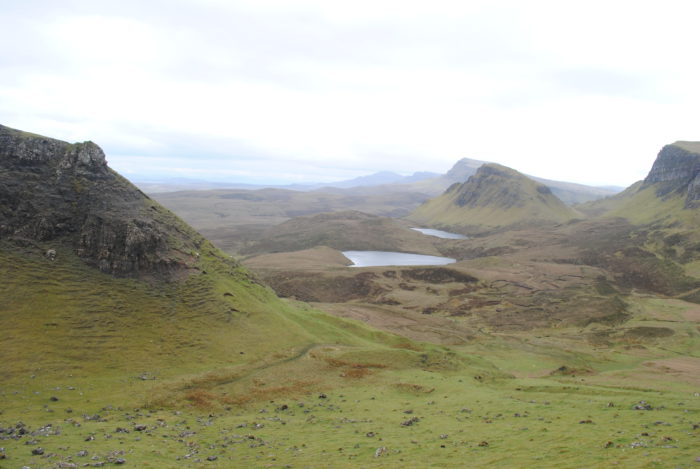
What a stormy day! Weather changes quiet quickly on the Island, so better be prepared for all kinds of conditions. We decided to do another hike today.
The Quiraing (in Gaelic: Cuith-Raing), situated in the north of Skye, is a loop walk with a distance of 6,8 km (4,23 miles), returning to the same point (the car park – it is not that big, so come early or you might have to park further down the road). It is the northernmost ridge of the Trotternish mountains and definitely worth the trip, as the different views are all amazing! Driving over the plateau from Uig or following the road that winds up from Staffin (other direction) until reaching the car park is already somehow spectacular. You can do the circuit heading out along the mountain´s base and returning above the escarpment or the other way. I liked the first option, as the landscape opens up as you walk along.
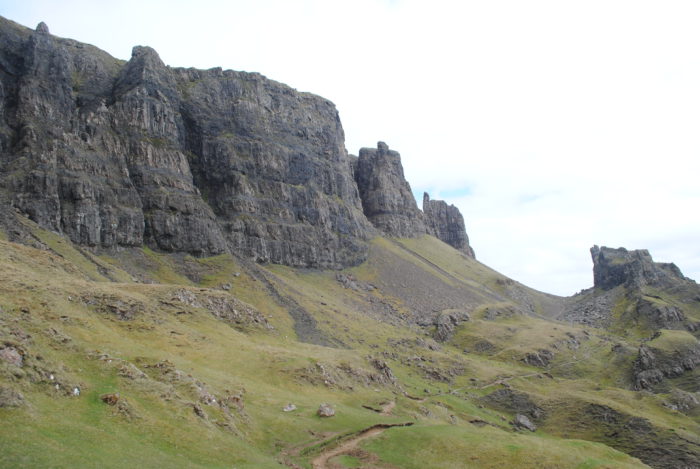
Just follow the right path from the car parking. You will see a very distinctive landscape of which some rock formations have their own names: The Needle is a 37 m high rock pinnacle, a remnant of former land slipping. Northwest of it a flat grassy area slipped down from the summit plateau, known as The Table. Southwest The Prison, a pyramidal rocky peak, is located.
Turning left at the base of the mountain base you will cross a small stone wall. As the walk continues the view opens up to the ocean. The landscape gets greener and grassier. Halt occasionally to just enjoy the breathtaking view!
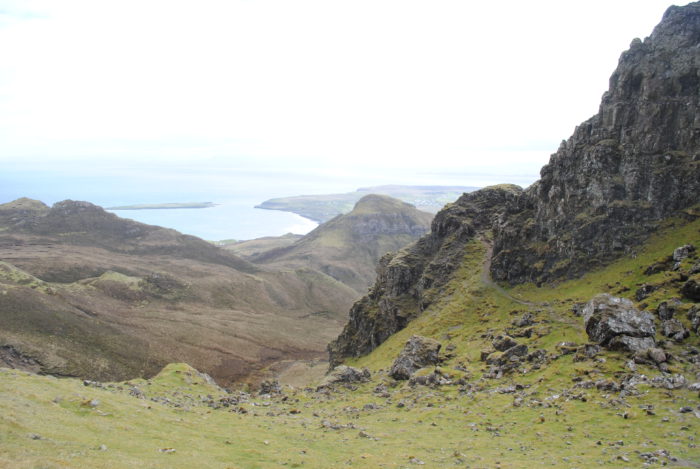
Continue on the upper path. After reaching a fence it´s time to take a break. You can decide whether to walk a short loop further up the hill on the right-hand side before continuing the main walk on the left. Great views ahead!
To overcome the escarpment that takes you back to the starting point you have to climb the marshy hillside. This is probably the most demanding part of the hike. So take your time, you will reach the top eventually to enjoy a wonderful view. Accompanied by the bleating of some sheep it is only a few more minutes down the hill to get back to the car parking.
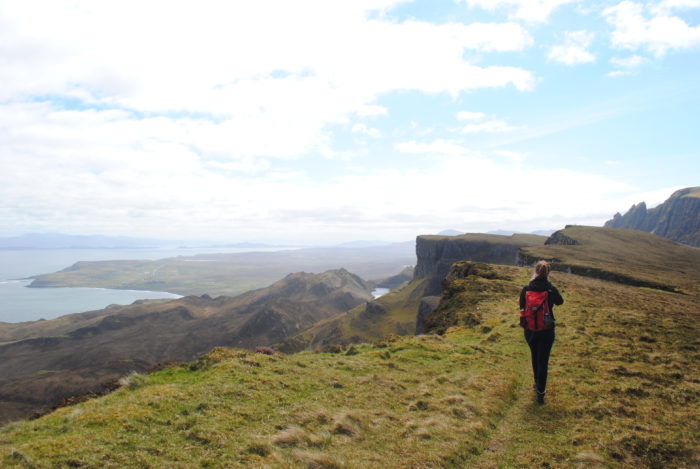
It was a windy but cloudless day and I would definitely not recommend this walk in bad or misty weather conditions. Nice surprise when you get back: a small wagon at the parking site sells tea, coffee, soup and snacks. We bought a hot tea and had some shortbread, before continuing our trip.
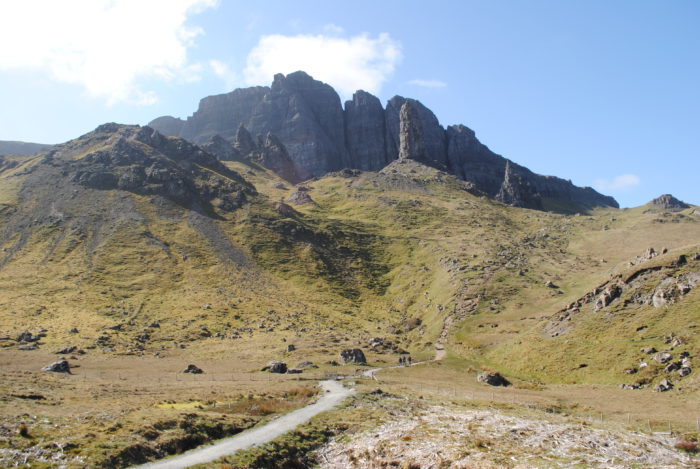
Up here already we could not miss visiting Old Man of Storr, the famous rugged rock formation with the 48 m pinnacle. The legend says, that a man and his wife were looking for an eloped cow when they met a group of giants. On the run, they looked back and turned into stone. The bizarre, mystical rock formation is approximately 50 Million years old. Amazing!
Being a little exhausted from the mid-morning hike we did not do the whole walk up.

On our way back around the island, we had our last stop of the day at the village of Portree which is the capital of the island with 2.400 inhabitants today. It is only about 200 years old and was created as a fishing village. The harbour is fringed by colourful houses infant of cliffs.
 We had dinner at the Isles Inn (Somerled Square, Portree, Isle Of Skye IV51 9EH). Try the mussels in a white wine sauce, it is really good!
We had dinner at the Isles Inn (Somerled Square, Portree, Isle Of Skye IV51 9EH). Try the mussels in a white wine sauce, it is really good!
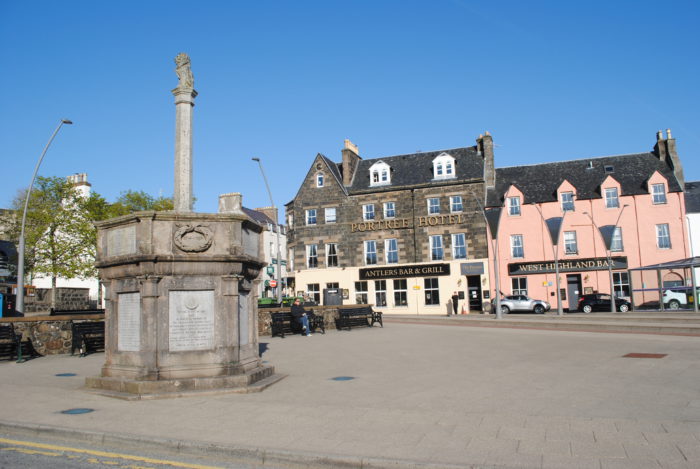
DAY 7 – Discover an enchanted world, spot Nessie & walk around a city in the Highlands
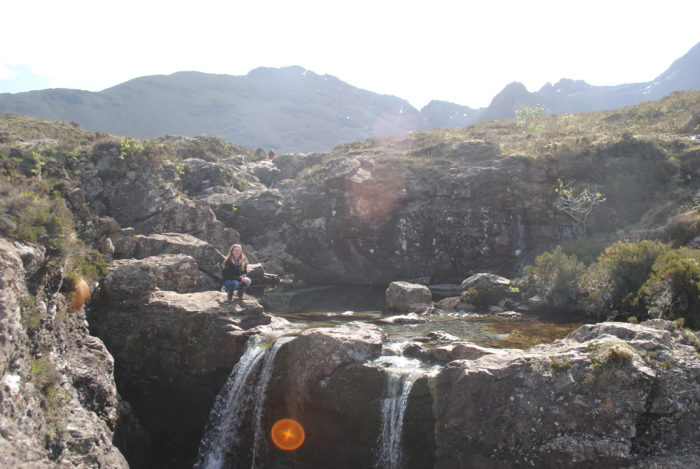
The so-called „Fairy Pools“ are definitely worth a visit. Following an easy walking path more and more water basins and falls appear. Come early and you will have many spots to yourself. If you have time, continue the walk into the mountains – from afar they looked appealing for a good hike. Maybe next time.
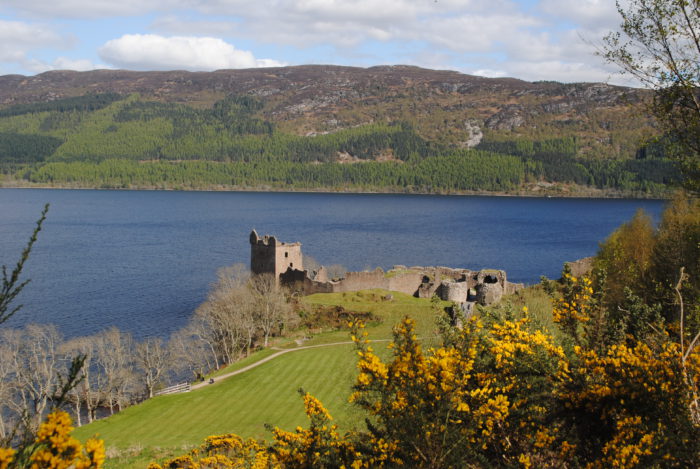
We continued our drive to Loch Ness. The legendary lake is far less spectacular than the story of the Loch Ness Monster, also known as „Nessie“, makes you expect. Well, we´ve seen it at least.
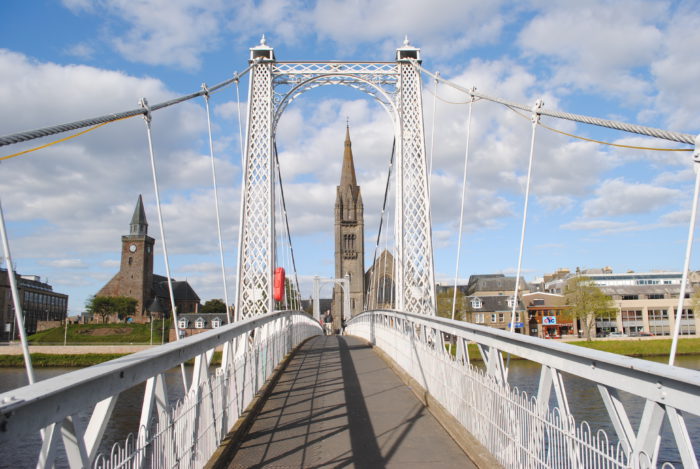
Inverness, a very nice city by the river Ness and 37 km (23 miles) northeast of the Loch Ness, is said to be the Highland capital. The Caledonian Canal connects the west and east coast. We enjoyed strolling around for an afternoon and could have spent some more time for sure.
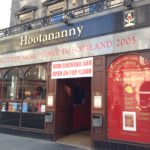 We had early dinner at Hootananny (67 Church St, Inverness, Inverness-Shire IV1 1ES), a restaurant and award winning pub (live music in the later evening) where real highland culture can be enjoyed in a very cosy atmosphere. You definitely have to eat a Sticky Toffee Pudding – it´s delicious!
We had early dinner at Hootananny (67 Church St, Inverness, Inverness-Shire IV1 1ES), a restaurant and award winning pub (live music in the later evening) where real highland culture can be enjoyed in a very cosy atmosphere. You definitely have to eat a Sticky Toffee Pudding – it´s delicious!
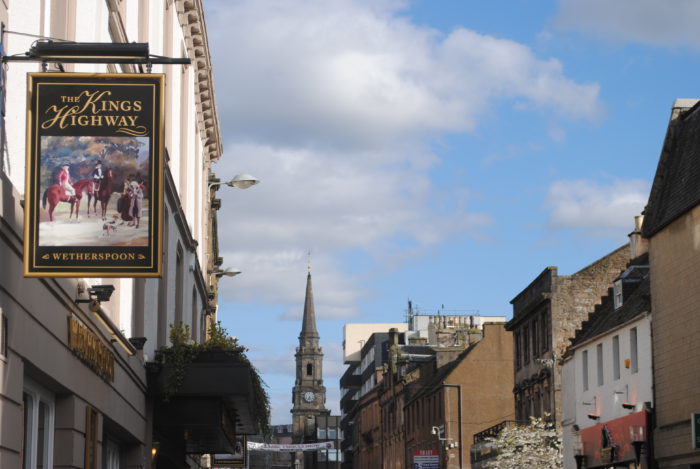
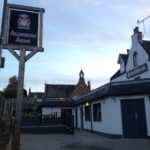 The Allangrange Arms (54 Millbank Rd, Munlochy, Ross-Shire IV8 8NL) was highly recommended to us by our hosts. After finally making it all the way to the pub, which is also a restaurant, we had a local beer. We only got lost once…
The Allangrange Arms (54 Millbank Rd, Munlochy, Ross-Shire IV8 8NL) was highly recommended to us by our hosts. After finally making it all the way to the pub, which is also a restaurant, we had a local beer. We only got lost once…
DAY 8 – Stop at the Whisky capital & drive thru a National Park
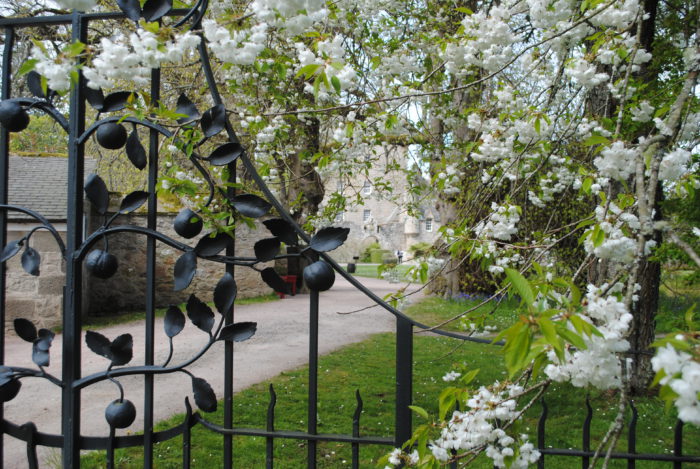
On our way to Aberdeen, we decided to take a panoramic route through the Cairngorms National Park. But first a few stops at the north coast:
With the intention to visit Cawdor Castle & Gardens 5 miles south west of Nairn we took a back road. The 14th century home of the Thanes of Cawdor became the setting of Shakespeares drama Macbeth in 1606. According to legend, the castle is built around a thorn tree. Due to the high entrance fee, we decided not to go inside. But already the drive through the impressive tree-lined road is worth it.
Tip: Buy an Explorer Pass if you want to visit many historic palaces, castles, abbeys and other sights and save some money. To see what´s included visit historic-scotland.gov.uk/explorer
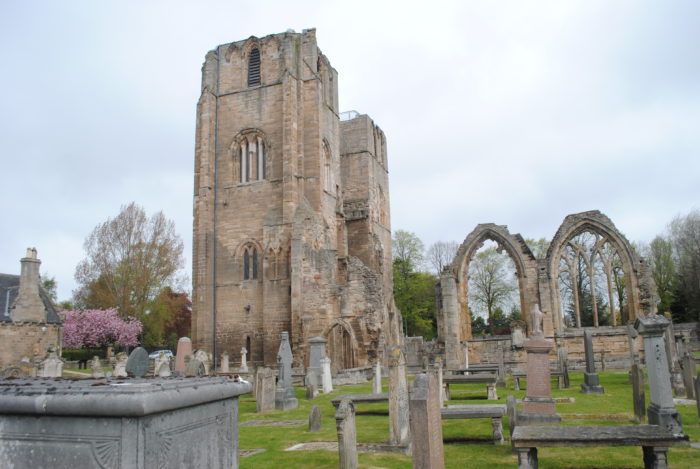
Our next stop was Elgin with the historic ruin of the Elgin Cathedral. Dedicated to the Holy Trinity it was established in 1224. Unfortunately, scattered showers kept us from walking around for very long. But it´s even impressive from the outside.

For a late lunch, we stopped at Dufftown, known as the capital of whiskey. The placid town is home to seven distilleries!
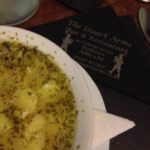 We had decent burgers (pulled pork) and a shrimp sandwich at The Stuart Arms Bar & Restaurant (22 Conval St, Dufftown, Banffshire AB55 4AE). You sit alongside the locals in a familiar atmosphere. We also tasted the traditional fish soup with the not very appealing name Cullen Skink. The thick soup made of smoked haddock, potatoes and onions is often served as a starter and a common everyday dish across the northeast of Scotland. I found it very good, but the very particular flavour is probably not everybody’s taste.
We had decent burgers (pulled pork) and a shrimp sandwich at The Stuart Arms Bar & Restaurant (22 Conval St, Dufftown, Banffshire AB55 4AE). You sit alongside the locals in a familiar atmosphere. We also tasted the traditional fish soup with the not very appealing name Cullen Skink. The thick soup made of smoked haddock, potatoes and onions is often served as a starter and a common everyday dish across the northeast of Scotland. I found it very good, but the very particular flavour is probably not everybody’s taste.
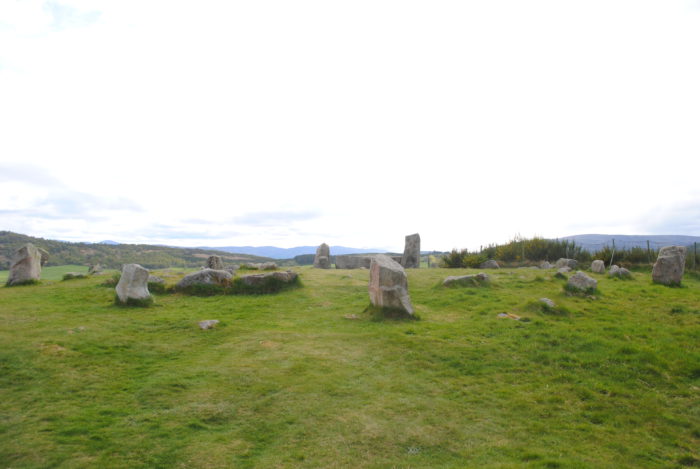
The Tomnaverie Stone Circle stands on a hilltop near the village of Tarlan. Farmers used it as an observatory to plot the movement of the seasons, but it was also a place for ritual practices. The stone circle with a diameter of about 18 m was utilized as a cremation cemetery as findings exposed. It was erected 4000 years ago in a truly spectacular location. The site can be reached by a short walk from a parking area.
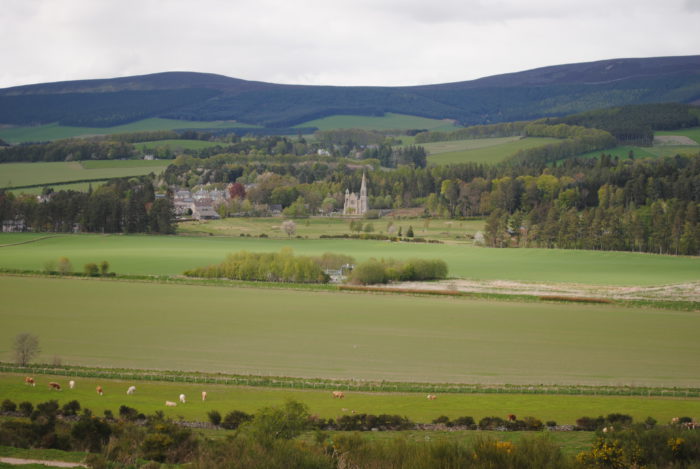
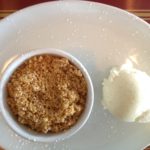 On towards Aberdeen, we stopped for a very tasty apple crumble at the Garlogie Inn (Garlogie AB32 6SA), a popular Bar / Restaurant in the countryside of Garlogie, near Westhill, Aberdeenshire. It dates back to the 1800’s when it was a Port & Ale House, a stop over point for coachmen to water their horses before heading up to Royal Deeside.
On towards Aberdeen, we stopped for a very tasty apple crumble at the Garlogie Inn (Garlogie AB32 6SA), a popular Bar / Restaurant in the countryside of Garlogie, near Westhill, Aberdeenshire. It dates back to the 1800’s when it was a Port & Ale House, a stop over point for coachmen to water their horses before heading up to Royal Deeside.
The third biggest city of Scotland is also known as the „Silver City by the Sea“: Aberdeen. This name originates from the grey granite used for many of the buildings and houses. Aberdeen is still dominated by its huge industrial port. Maybe it´s just the first look and the city is underestimated, but we did not quite warm up to it…
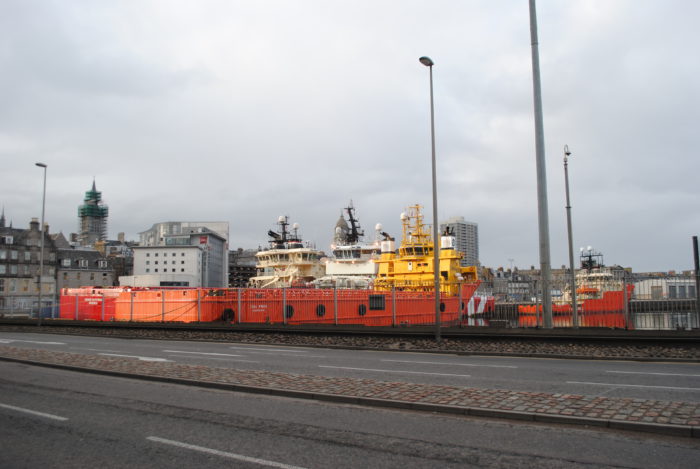
DAY 9 – Enjoy the east cost & eat a legendary dish
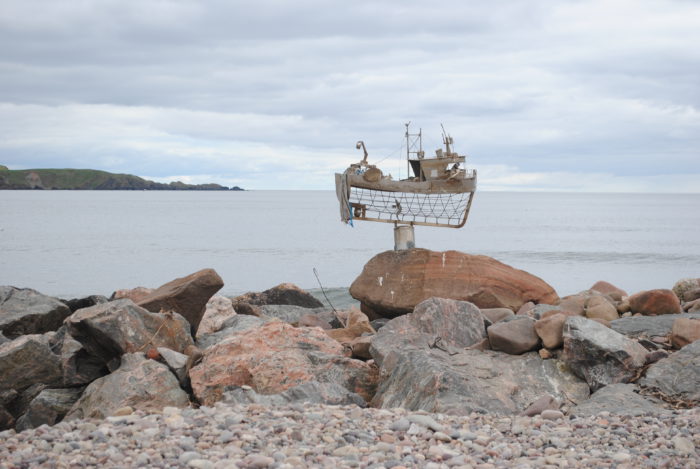
We left early in the morning for our drive to Edinburgh. Our first stop today was the town of Stonehaven approximately 25 km (15 miles) South of Aberdeen. It is surrounded by cliffs on both sides and has a very nice little harbor.
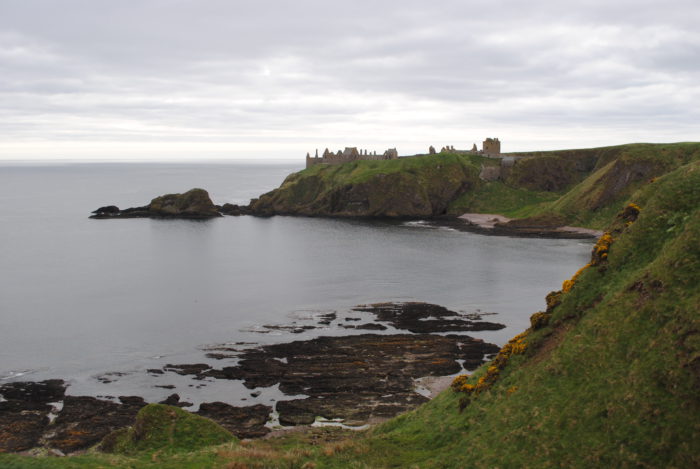
Roughly 3 km (1,9 miles) from the town centre, which is half an hour walk, dramatically lies Dunnottar Castle. The ruined medieval fortress rests on a rocky headland and is surrounded by steep cliffs. It has a long history dating back to the Early Middle Ages when a place of worship was built at Dunnottar in the 4th century. The castle has played a prominent role in the history of Scotland ever since because of its strategic location – it is known as the place where the Scottish crown jewels were hidden in the 17th century for instance. Unfortunately, we did not have time to see the inside of the castle, because we had to get back to our car (tip: release a parking ticket for several hours in the town centre).
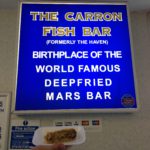 On our way back I had a really good scone at The Cool Gourmet (23 High St, Stonehaven, Kincardineshire AB39 2JP). Highly recommend the place! Have a tea and some pastry and enjoy the friendly atmosphere. Incidentally, we passed by another special place: The Carron Fish Bar (1 Allardice St, Stonehaven AB39 2BN). You have to eat a legendary dish here because the place is known as the birthplace of the deep fried mars bar. This high-calorie snack is one for sharing – veeeeeery sweet, but delicious!
On our way back I had a really good scone at The Cool Gourmet (23 High St, Stonehaven, Kincardineshire AB39 2JP). Highly recommend the place! Have a tea and some pastry and enjoy the friendly atmosphere. Incidentally, we passed by another special place: The Carron Fish Bar (1 Allardice St, Stonehaven AB39 2BN). You have to eat a legendary dish here because the place is known as the birthplace of the deep fried mars bar. This high-calorie snack is one for sharing – veeeeeery sweet, but delicious!
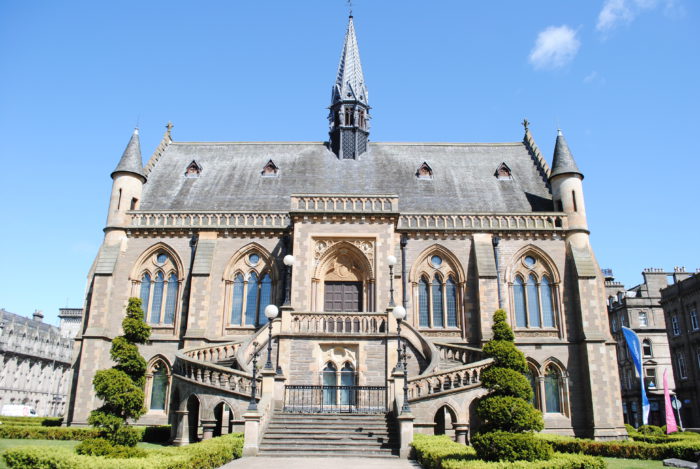
The next city did not impress us too much, even though Dundee is undergoing a huge process of change at the moment. With the opening of the V&A Museum of Design in 2018, the city will become a new international centre of design for Scotland. As an architecture enthusiast, I’m curious about it! Get a map for the „Dundee Heritage City Centre Walk“ at the tourist information by the city square to gain a quick overview of the city.
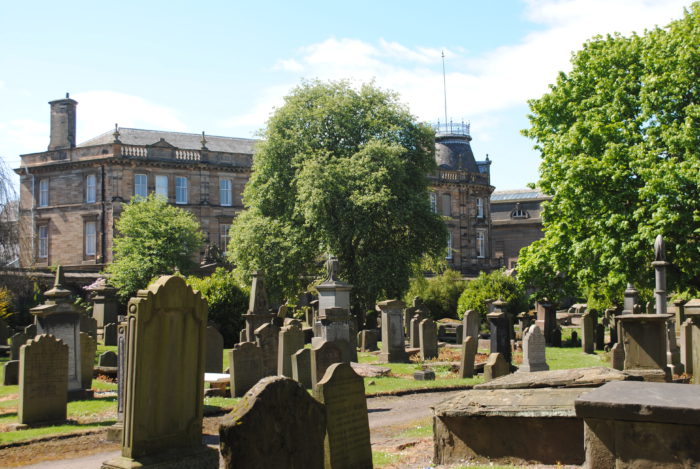
Crossing the Firth of Tay by the Tay Road Bridge we drove further down south over the Fife Peninsula. Worth a stop is the Tayport Promenade, a beautiful nature area.
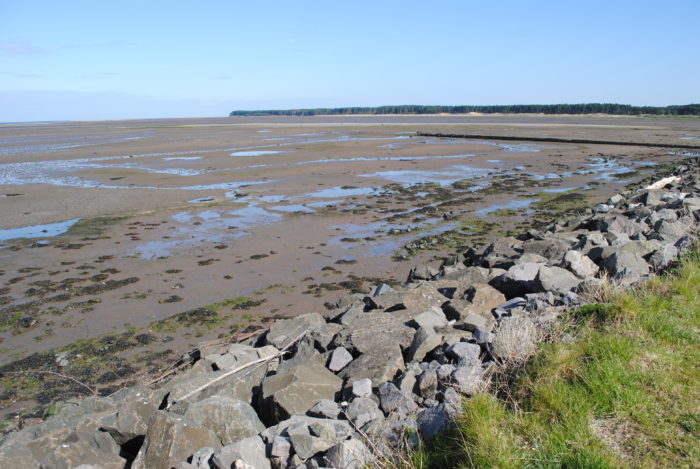
Some 10 miles (16 kilometres) southeast of Dundee lies St. Andrews, home to the University of St Andrews which is known not only as the oldest in Scotland but as the third oldest university in the English-speaking world. We bought an ice cream and drifted through the small town. Most impressive for us were the ruins of the Cathedral of St Andrew that was built in 1158 as a Roman Catholic church.
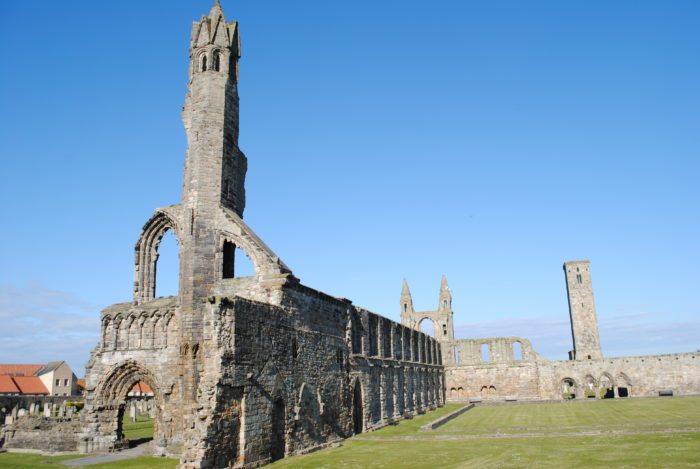
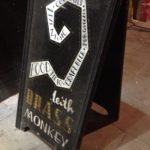 Leith is usually a bit cheaper than central Edinburgh. At The Brass Monkey Leith (
Leith is usually a bit cheaper than central Edinburgh. At The Brass Monkey Leith (
Day 10 – Visit a Scottish mansion in the south
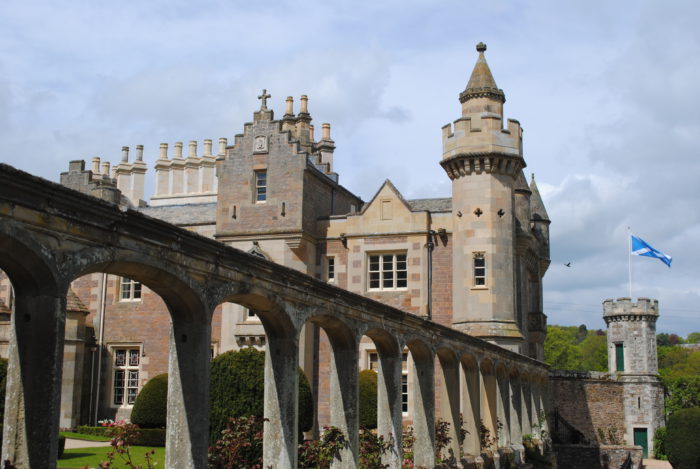
Before exploring Edinburgh we had our car for one more day and decided to drive a bit down south. Our first stop was Abbotsford, the Home of famous Scottish writer Sir Walter Scott near Melrose (Abbotsford, Melrose, Roxburghshire TD6 9BQ). Since 200 years is stands like a castle overlooking the river Tweed.
The exhibition about the life story of Sir Walter Scott in the modern Visitor Centre is worth discovering. We did not want to spend the money to visit the house itself, but you can walk around the gardens and the estate on your own. The view of the house from the terrace of the Visitor Centres restaurant is also pretty nice – and the scones & tea very delicious!
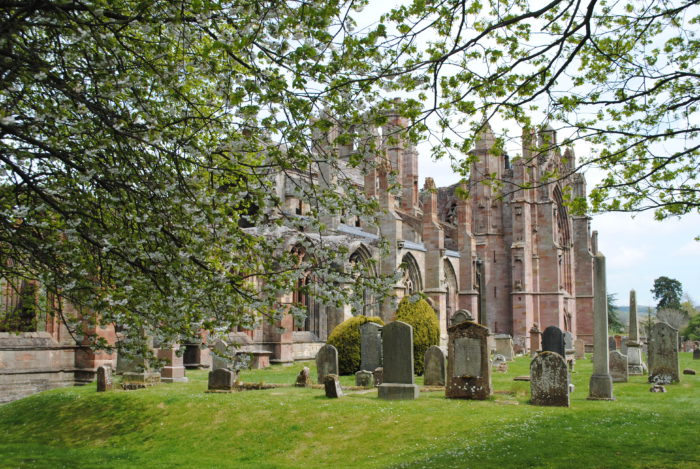
One of the most magnificent ruins in all of Scotland is probably well known and lavish Melrose Abbey (Abbey Street, Melrose, Roxburghshire, TD6 9LG). It was founded in 1136 by David I for the Cistercian Order, but unfortunately – being so close to the border – largely destroyed by the English army in the 14th century. The surviving remains of the church date back to the early 1500s. We only peeked through the walls because we did not have too much time but it´s probably worth visiting.
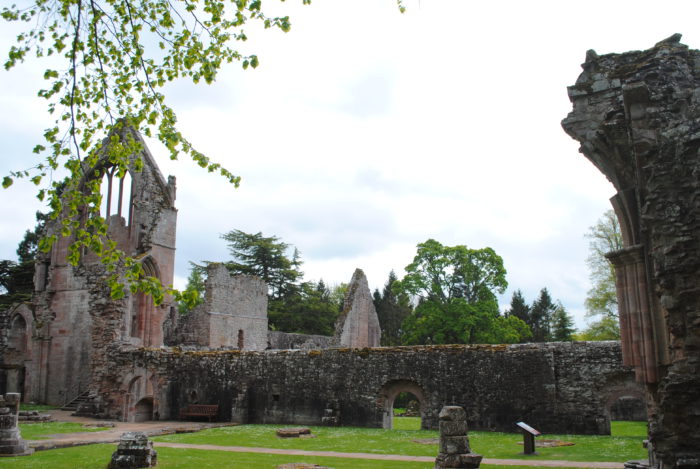
Another medieval ruin nearby is Dryburgh Abbey (Dryburgh, St Boswells, Roxburghshire, TD6 6RQ) which was built in (Gothic) ecclesiastic architecture and masonry style. It dates back to 1150. The secluded and peaceful location gave us a sense of how monastic life must have been. Sir Walter Scott was buried in the cemetery.
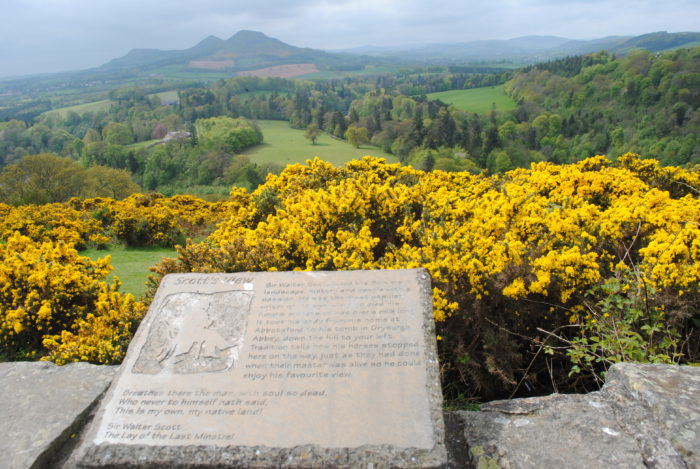
3 miles east of Melrose we stopped at a viewpoint. I can totally understand, why an author would come here for inspiration. What a wonderful sight from this place called Scott´s View overlooking the river Tweed and the surrounding valley!
Peebles is a cute and busy town in Tweeddale within the Scottish Borders region only 32 km (20 miles) south of Edinburgh. The former market town played a role in the woollen industry up until the 1960s. Today you can still find a household supply store, vintage confectioners and a Chocolate & Pastry School apart from small cafés and stores.
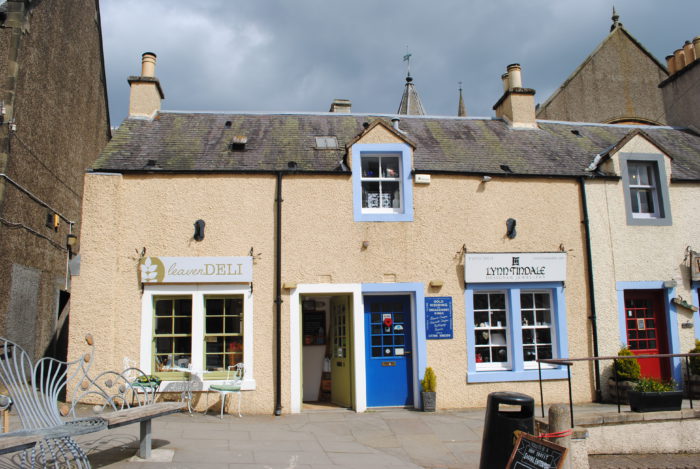
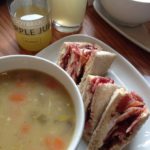 The Eastgate Theatre & Arts Centre (Eastgate, Peebles EH45 8AD) occupies a former church building constructed in 1871 in the centre of Peebles. Since 2004 it is a vibrant hub for live performances, films, classes and exhibitions. We had drinks and snacks at the Café as well as local apple juice – tasty!
The Eastgate Theatre & Arts Centre (Eastgate, Peebles EH45 8AD) occupies a former church building constructed in 1871 in the centre of Peebles. Since 2004 it is a vibrant hub for live performances, films, classes and exhibitions. We had drinks and snacks at the Café as well as local apple juice – tasty!
Before returning to Edinburgh we had to stop at Rosslyn Chapel (Chapel Loan, Roslin, Midlothian, EH25 9PU). It became popular after Dan Brown’s book „The Da Vinci Code“ was published. The church with the foundations from 1446 was known for the unique and mysterious carvings before. It took some 40 years to complete the ornate stonework in- and outside the building. According to legend, the treasure of the fabled Knights Templar, the Holy Grail, is stored in a stone crypt inside the chapel. Today, theories and mystery remain.

Back in the city, we had some hearty dinner (pie and beer) in Edinburgh New Town. There you can find long-established pubs alongside many new restaurants with a wide range of worldwide cuisine.
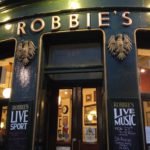 This is how you imagine a real British (or in this case Scotish) Pub! Robbie´s (367 Leith Walk, Edinburgh EH6 8SE) has it all: the locals (of all ages) hanging around, an extensive beer and whiskey menu and events on most nights, including Quiz Night (Tuesday @ 8 pm) and Poker Night (Thursday @ 8pm).
This is how you imagine a real British (or in this case Scotish) Pub! Robbie´s (367 Leith Walk, Edinburgh EH6 8SE) has it all: the locals (of all ages) hanging around, an extensive beer and whiskey menu and events on most nights, including Quiz Night (Tuesday @ 8 pm) and Poker Night (Thursday @ 8pm).
DAY 11 – See the Edinburgh castle & stroll down the ‚Royal Mile‘
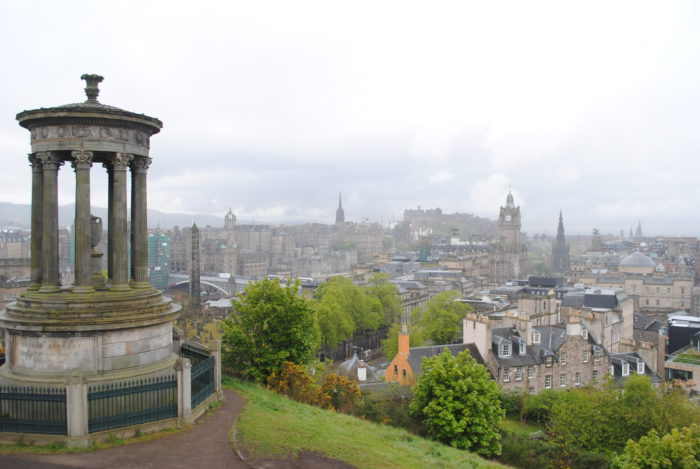
When you look at the map of Edinburg it seems to be pretty green. There are a few bigger parks and green spaces within the city. We decided to climb a smaller hill for a nice overlook. The views from Calton Hill are great, even when the weather isn´t so good.
Most recognisable is the National Monument of Scotland. It is part of the UNESCO World Heritage, once intended as a tribute to the Scottish soldiers who died in the Napoleonic Wars in the 19th century. The project ran out of money and was left unfinished. Today many Scotish people like to think of it as the „Athens of the North“.
More information about World Heritage sites in Edinburgh.

National Monument of Scotland at Calton Hill © Lisa Lehnen
In 1818 William Henry Playfair designed a Greek temple styled building on the top of Calton Hill as a City Observatory for watching and studying the stars. Today the observatory is used by the Collective, a contemporary visual arts organisation, that wants to reuse the complex as a common space, opening the building to the public for the first time in 2018: „Our vision is to be a new kind of City Observatory for Edinburgh bringing people together around innovative art and iconic heritage.“ We are excited to see what kind of developments will be going on! At the moment there are a Café and a small exhibition.
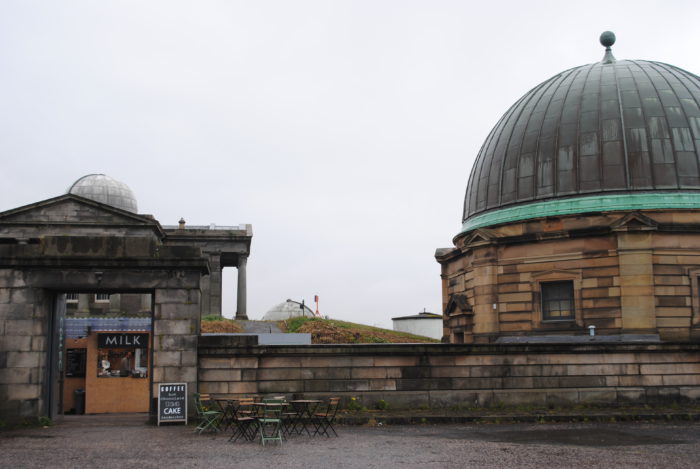
There is a little café at the City Observatory and City Dome © Lisa Lehnen
Via a 143-step climb, we reached the top of the Nelson Monument. The 360-degrees-view of the ocean and the neighbouring Arthur’s Seat are astonishing – and free! Six days a week at one o´clock a ball drops down a mast, signalling the simultaneous gun shot at the Edinburgh Castle.
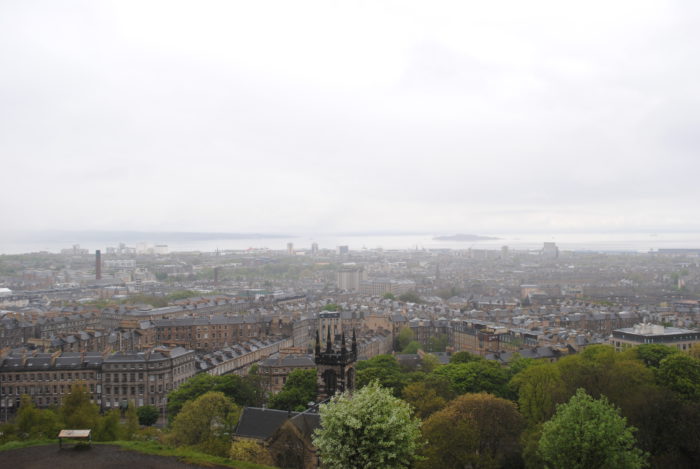
After it stopped raining it was time for us to explore a bit more of the old city centre. The Royal Mile was and still is the main street of the historic Edinburgh. It is a famous tourist spot today and usually crowded. The street stretches from the Edinburgh Castle all the way to the Palace of Holyroodhouse. Many smaller roads intersect with The Royal Mile and quite a few (hidden) laneways can be used as shortcuts to the upper or lower streets.
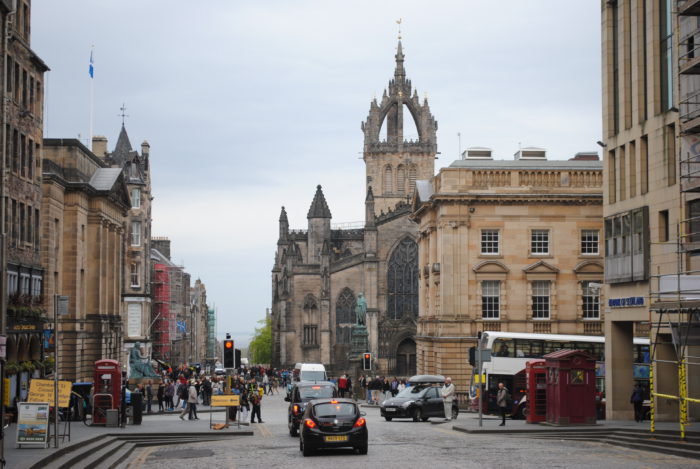
Heart of Edinburgh: The Royal Mile © Lisa Lehnen
For us, this was one of the most interesting parts of the city! You can walk up and down many times and you will always discover something new. A store you didn´t notice before, a funny sign you haven´t seen.
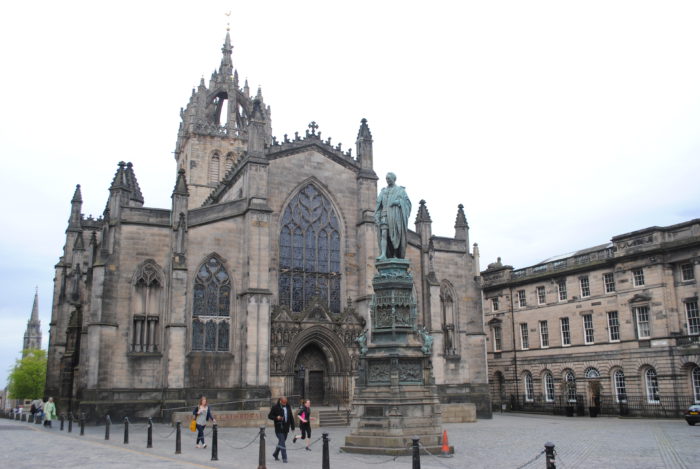
St Giles‘ Cathedral is most noticeable for its crown spire and the great location on the Royal Mile. The present building dates back to the late 14th century (it has been last restored in the 19th century), but the church itself has a religious history of more than 900 years. It has been the principal place of worship of the Presbyterian Church of Scotland in Edinburgh ever since. Therefore it is also known as the „High Kirk of Edinburgh“.
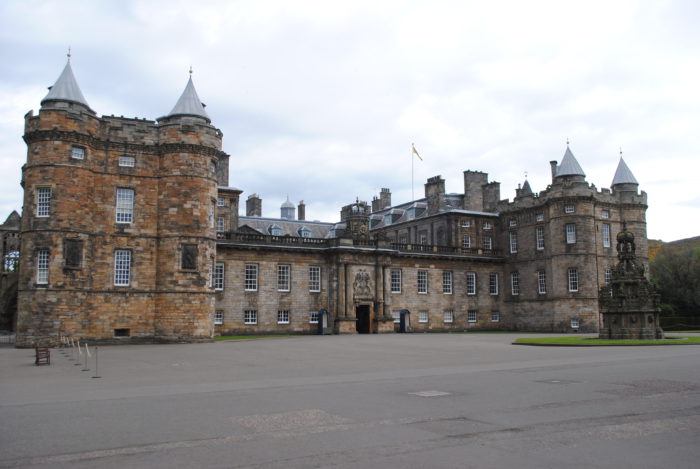
As we walked down the Royal Mile we suddenly found ourselves in front of the Disney-like looking Palace of Holyroodhouse (Canongate, Royal Mile, Edinburgh, EH8 8DX) which is located at the end. It is the Queen’s official residence whenever she visits Scotland. Unfortunately, she wasn´t there and the palace was already closed for visitors. 14 of the historic State Apartments and the affiliated Queen’s Gallery with changing exhibitions from the Royal Collection can be visited.
Across the street is the fancy building of The Scottish Parliament (Canongate, EH99 1SP). Inside the controversial but also award-winning building designed by Catalonian architect Enric Miralles there is a free permanent exhibition about the Scottish Parliament.
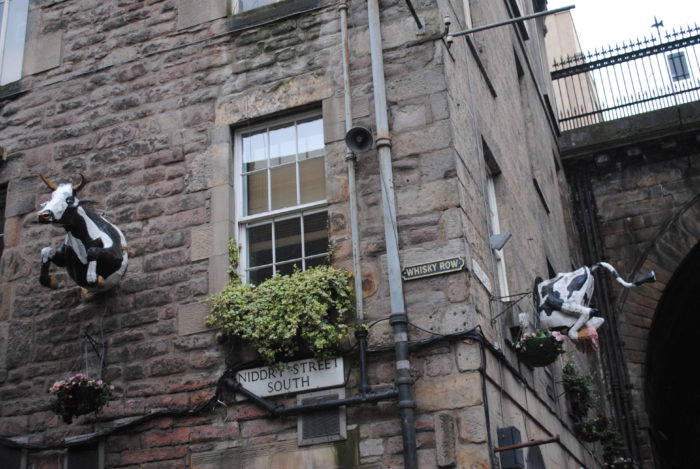
We decided to discover a bit of the darker side of the cities history and joined a Free Ghost Tour. In one and a half hours we learned more about why Edinburgh is known as one of the most haunted cities in Europe, walked through the Greyfriars‘ churchyard and listened to some bloodcurdling stories. It’s definitely not a tour for the faint-hearted!
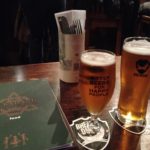
To end the day well enjoy a decent dinner and a fresh beer – we can recommend the „BrewDog“ – at a typical pub-style restaurant in the old town: Albanach (
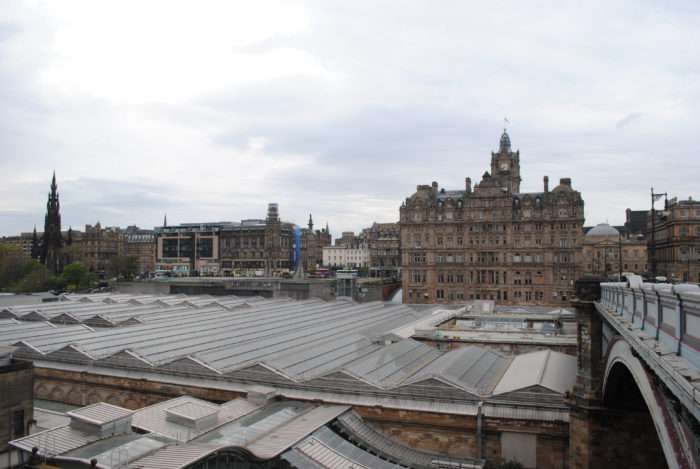
Edinburgh train station and The Balmoral hotel seen from the North Bridge © Lisa Lehnen
DAY 12 – Eat a Scottish breakfast & explore some free museums
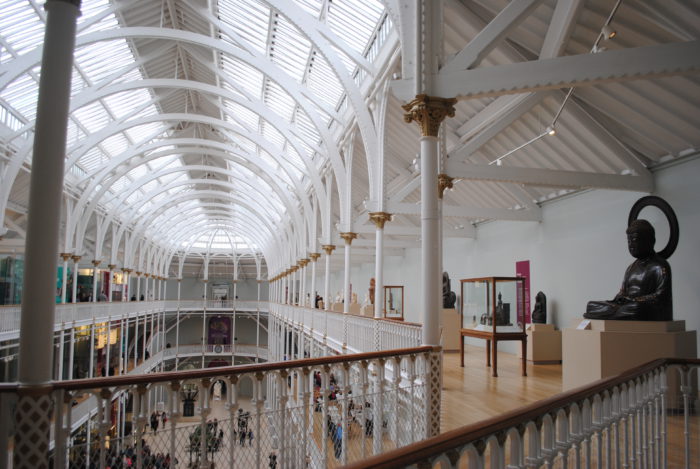
Even though May is the „golden month“ in Scotland the weather isn´t always great. But there are also things that make a rainy day a nice day in Edinburgh. Lots of shops, museums and galleries to stroll around in.
 Start your day right with a real English breakfast! We had ours at The Inn On The Mile (82 High St, The Royal Mile, Edinburgh, EH1 1LL) which is not only a restaurant but also a hotel. Service is nice, food was good.
Start your day right with a real English breakfast! We had ours at The Inn On The Mile (82 High St, The Royal Mile, Edinburgh, EH1 1LL) which is not only a restaurant but also a hotel. Service is nice, food was good.
An absolute Must-See in Edinburgh is the Royal Museum / National Museum of Scotland (Chambers Street, Edinburgh, EH1 1JF). Not only is the building with the spacious and light-flooded Grand Gallery very beautiful, but also the exhibitions are worth exploring. We only had a few hours which was definitely not enough.
You can time-travel back through Scottish history and learn more about the country’s royalty. The Millennium clock chimes the hour with a unique musical display, representing the best and worst things that happened in the 20th century.
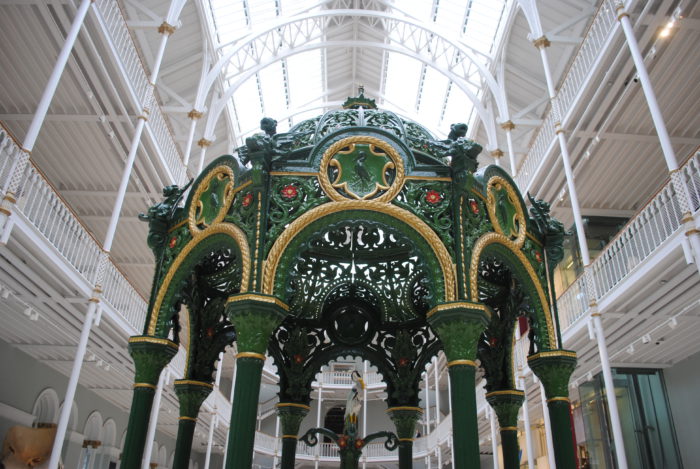
The Natural World galleries take you to the wonders of nature and display some already extinct species. There is a lot to learn throughout the Science and Technology galleries. And there is much more. Last but not least the roof top terrace of the museum is worth a visit: the views over the city are spectacular. The best thing about the museum: it´s totally free!
Also free to visit are the Scottish National Gallery of Modern Art and the Scottish National Gallery.
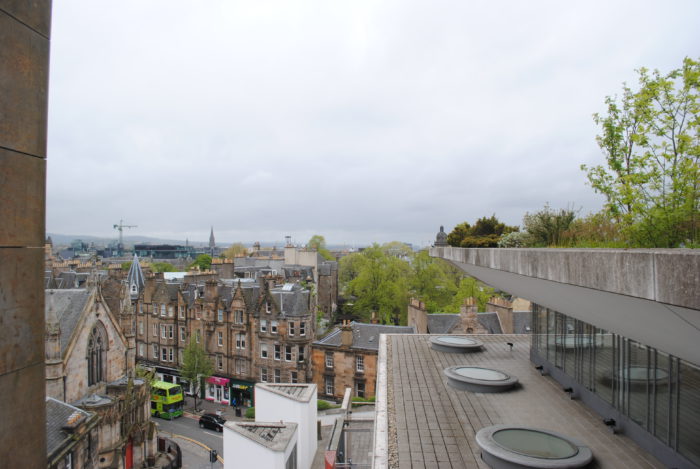
View from the roof top terrace of the Royal Museum / National Museum © Lisa Lehnen
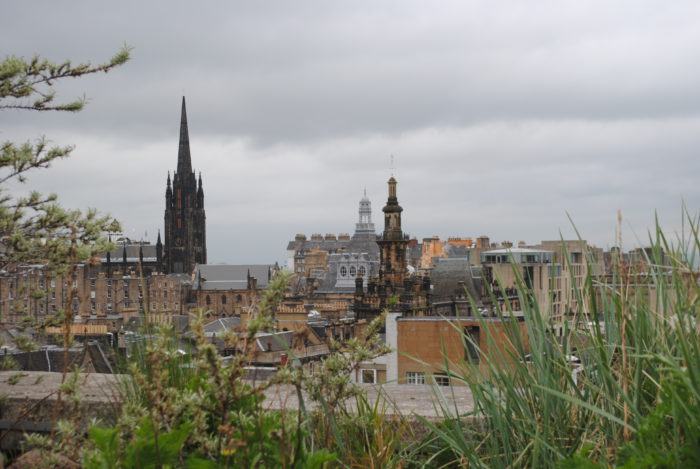

A nice way (and view) to say goodbye to Edinburgh and Scotland © Lisa Lehnen
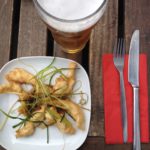 If you want something different but Scotish food for a change, you can head to Boteco do Brasil (
If you want something different but Scotish food for a change, you can head to Boteco do Brasil (
BYE BYE Scotland, nice to meet you! We leave with good memories of a beautiful and friendly country. And we can´t wait to come back one day to explore more.